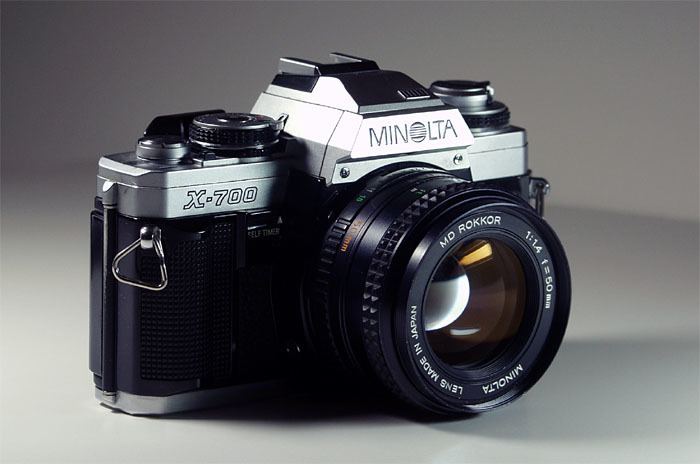Focus Manual | ||
 | ||
Dimensions 51.5 x 89 x 137mm, 505g | ||
The Minolta X-700 is a 35 mm single-lens reflex film camera introduced by Minolta in 1981. It was the top model of their final manual-focus SLR series before the introduction of the auto-focus Minolta Maxxum 7000.
Contents
Features
The X-700 used the basic body of the XG-M with electronically controlled stepless speeds, but added full program autoexposure in addition to the XG-M's aperture priority and metered manual modes. It also introduced through-the-lens (TTL) flash metering, and added exposure lock and interchangeable focusing screens to the XG-M's features. Based on the X-700 chassis, Minolta later launched the cheaper models X-300 and X-500. The X-500 lacked the X-700's program exposure mode, but featured a fill-in flash mode. The X-300 was the basic model of the late X-series. It lacked TTL flash metering and program exposure mode, it did not show the f-stop-setting of the lens in the viewfinder and it did not have a depth-of-field control button. Basic parts of all three cameras, such as the shutter, viewfinder, mirror system, and light metering system, were identical.
Motivated by the huge success of the low-priced Canon AE-1 and other consumer-level cameras, Minolta followed suit in the new camera's design by offering more external camera features. This had the effect of lowering the budget for the camera's internal mechanism. In a step backwards, the new X-700 was not equipped with the fast vertical metal shutter of previous XE and XD cameras, and was instead fitted with a less expensive horizontal traverse silk shutter, enabling maximum sync speed of 1/60 second, and operated by an electromagnetic shutter release. No mechanical shutter speed was provided, even in bulb mode. The resultant battery drain and inability to meter at light levels below EV-1 made the camera a poor choice for long exposures, as often needed for astrophotography. Minolta further lowered the price of the camera by fabricating certain parts in the film advance and rewind mechanism of less expensive materials, and by the use of less expensive electronic components. Even the rewind lever of the camera is made of plastic.
History
In 1981, the X-700 was awarded the European "Camera of the Year". Its competitive pricing resulted in its becoming the most successful Minolta camera since the SRT line.
As Minolta began to introduce its auto-focus cameras and lenses, further research and development of manual-focus 35mm SLR cameras was shelved. Some internal components of the X-700 were changed over its production run, apparently in an effort to further reduce costs. Minolta was also one of the first major 35mm SLR manufacturer to outsource assembly of its cameras to countries outside Japan. They moved production of their X-300 to China in 1990, where the Seagull Camera factory took over production.
In 1999, the X-700 camera was discontinued.
